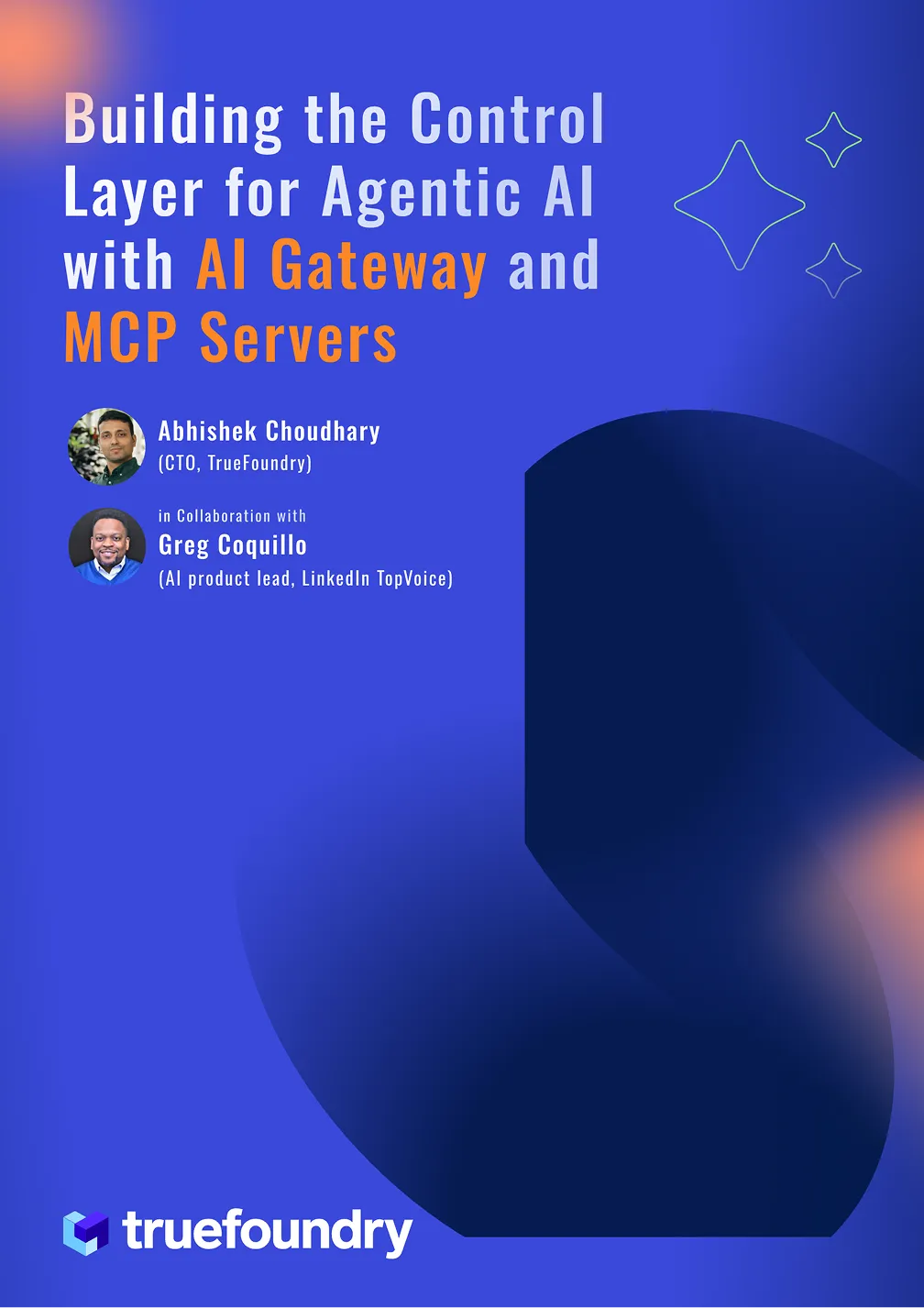Understanding Total Cost of Ownership for GenAI Infrastructure
As generative AI (GenAI) sees wider adoption across industries, decision-makers are increasingly tasked with determining the most effective ways to develop GenAI solutions. One of the core considerations is the Total Cost of Ownership (TCO)—the comprehensive evaluation of all costs involved in building, deploying, and maintaining GenAI solutions over their lifecycle.
This blog will provide insights into the key elements of TCO for building GenAI infrastructure in-house versus leveraging a managed platform like TrueFoundry.
TCO in context of GenAI Infrastructure
When evaluating the cost of GenAI models, it’s essential to look beyond upfront expenses such as software licenses or infrastructure. TCO encompasses the entire cost lifecycle—from the initial setup and development to ongoing maintenance, scaling, and operational costs.
Total Cost of Ownership (TCO) = (Upfront Infrastructure Costs) + (Development and Deployment + Scaling Costs) + (Maintenance Costs) + (Security and Compliance Costs) + (Decommissioning Costs) + (Software Licencing cost) + (Talent cost) − (Productivity Boost Savings)
This formula doesn't account for certain intangible benefits, such as the opportunity cost of lost time to market or potential costs from system outages, because these are difficult to quantify. Factors like opportunity cost are subjective and should be considered as part of a broader qualitative analysis.
Total Cost of Ownership
Infrastructure costs
Using Kubernetes: TrueFoundry provisions instances directly from cloud providers (like AWS, GCP, or Azure) or on bare-metal hardware with a Kubernetes layer on top, without adding extra costs.We remove all the complexities of Kubernetes, enabling you to harness its full potential without the hassle.. In contrast, SageMaker typically charges 20-40% more per instance compared to provisioning the same instance directly through EC2, due to the additional managed services offered by SageMaker.
Spot Instances: TrueFoundry can leverage spot instances (available at a fraction of the cost of on-demand instances) with on-demand fallback, ensuring reliable performance while reducing costs.
Storage and Egress Optimization: TrueFoundry uses shared volumes to minimize data egress charges, which can be significant in cloud-based environments where large amounts of data are transferred
Intelligent AutoPilot : TrueFoundry’s Autopilot automatically detects and resolves infrastructure inefficiencies as your workloads change, avoiding overprovisioning costs.
First-Time Infrastructure Accuracy: TrueFoundry configures infrastructure correctly from the start, avoiding costly reconfigurations and time wastage.
Flexibility to Switch Between Cloud Providers: TrueFoundry enables seamless switching between cloud providers, allowing businesses to take advantage of the best pricing and features.
Customizable Resource Constraints per Workspace: TrueFoundry allows precise customization of CPU, memory, storage, and instance types per workspace to match specific project needs.
Let's assume an enterprise incurs an infrastructure cost of $1 million per year for running multiple workloads (based on industry estimates). TrueFoundry can help reduce this cost by at least 30%, resulting in $300,000/year in savings.
Development, Deployment & Scaling Costs
Autoscaling: Automatically adjusts compute resources in real-time based on workload demands, without manual intervention.
Scale to Zero: Reduces resource consumption to zero during idle periods, minimizing costs when resources are not in use.
Adaptive Resource Usage: Flexibly switch between CPU and GPU on the same machine, using GPU resources only when necessary to optimize allocation and avoid maintaining them constantly.
Error Prevention for Training: Platform ensures reliable infrastructure and correct configurations to prevent training errors, reducing wasted compute resources and avoiding costly re-runs.
Checkpointing for Long Jobs: Saves time and compute by enabling checkpointing for long-running jobs, allowing them to resume from where they left off in case of interruptions.
Efficient Fine-Tuning: Offers resource-efficient fine-tuning methods like LoRA and Q-LoRA, reducing resource consumption while helping you achieve your goals cost-effectively.
Optimized Model Serving: Provides pre-configured model serving setups based on benchmarking, ensuring the best possible latency and throughput for your workloads.
Built-In SRE Principles: Integrates seamlessly with CI/CD pipelines and securely manages sensitive information such as API keys and tokens, following best practices for reliability and security.
Cost Visibility: Provides visibility into cloud costs at the cluster, workspace, and deployment levels, empowering DevOps teams and developers to identify and optimize cost-saving opportunities throughout the lifecycle.
Through these built in platform features through out such as autoscaling, scale to zero even for dev workloads, ability to resume from checkpoint, optimizations from model serving and avoiding devops bandwidth for setting up CI/CD we would be around $100k.
Estimation - Assuming 30% of cloud costs( assumed to be $1 million dollar) is being used in training and serving i.e. $300k. Even a 30% save via these platform offering will result in $90k savings
Maintenance Costs
TrueFoundry handles the monitoring of infrastructure, upgrading dependencies, and managing security patches, ensuring your system stays up to date without additional overhead. Additionally, the responsibility for managing technical debt is fully transferred to TrueFoundry, freeing your team from the long-term burden of maintenance and updates.
Infrastructure Monitoring, Dependency Upgrades, and Security Patches: Typically, a full-time DevOps engineer or team would be required to manage these tasks, costing an organization approximately $120,000–$150,000/year per engineer. With TrueFoundry automating this, you can potentially save this entire amount by eliminating the need for dedicated DevOps resources.
The long-term cost of managing technical debt can vary, but it typically involves spending developer time on refactoring and system updates. On average, managing technical debt can consume 20% of a developer’s time, which could amount to $30,000–$50,000/year per developer.
With TrueFoundry handling maintenance, you can expect to save approximately $120,000–$200,000/year by reducing DevOps costs and reducing the impact of technical debt.
Security and Compliance Costs
The responsibility for managing role-based access controls, data privacy, and ensuring successful completion of regular compliance audits is fully transferred to TrueFoundry. This alleviates the need for internal teams to handle these critical tasks.
Compliance audits and maintaining security standards can typically cost an organization $50,000–$100,000/year depending on the complexity of the requirements. By shifting this responsibility to TrueFoundry, you can potentially save this entire amount while ensuring ongoing compliance.
Decommissioning Costs
TrueFoundry is designed with a core philosophy to avoid vendor lock-in, making it simple for you to transition off the platform if needed.
- We provide access to the Kubernetes manifest file, giving you complete control and visibility over your infrastructure.
- Your application code remains untouched, so migrating off doesn’t require extensive refactoring.
- Additionally, TrueFoundry integrates effortlessly with your existing tech stack, allowing workflows such as train on platforms like SageMaker and deploy on TrueFoundry. There's no need for a full system migration—our API-driven approach works seamlessly with what you already have.
Decommissioning cost can be assumed to be almost zero with Truefoundry.
Talent cost
Continuously hiring specialized talent, including ML engineers, DevOps professionals, infrastructure architects, and security engineers, is essential to manage complex systems and maintain scalability. These roles are critical for future-proofing your infrastructure and staying ahead of evolving technology demands.
The exact team size will depend on the scale of your operations and the use cases being developed. However, assuming a team of 8, including an infrastructure architect, security engineer, DevOps engineer, SRE/operations engineer, and ML engineers, with an average salary of $150,000, the total talent cost would be $1.2 million per year.
Software Licencing cost
Our licensing costs are based on seat-based pricing, not on compute usage, meaning the cost doesn’t increase as you scale up your infrastructure.Unlike cloud providers or platforms like Databricks that charge based on usage, our pricing model is focused on maximizing developer productivity, ensuring you won’t be penalized for scaling your operations.
For a large enterprise team, a production license typically ranges between $100k–$150k, though it may vary depending on specific needs.
Productivity Boost Savings
Faster Onboarding: TrueFoundry’s intuitive platform enables faster onboarding of new developers, reducing the time spent learning the infrastructure and boosting team productivity from the start.
Intuitive UI/UX and Comprehensive Documentation: The platform provides an easy-to-navigate UI/UX and thorough documentation, enabling teams to work more efficiently with less time spent troubleshooting or navigating complex systems.
Better Collaboration: TrueFoundry’s shared workspaces and integrated tools enhance collaboration across teams, ensuring smoother workflows and reducing silos, leading to faster project completion.
Even with a minimal 10% savings in time for an 8-member team, assuming an average salary of $150,000 per engineer, the estimated productivity boost savings would be $120,000/year, resulting from reduced time spent on infrastructure management, streamlined collaboration, and faster onboarding.
Total Cost of Ownership: In-House vs. TrueFoundry

Total Estimated Cost Comparison
- In-House Solution: $2.5 million/year (including infrastructure, talent, maintenance, and security costs).
- TrueFoundry Solution: $1.4 million/year (after accounting for savings in infrastructure, talent, security, and maintenance costs).
TrueFoundry’s automation, infrastructure optimization, and reduced overhead provide significant cost savings compared to building and managing an MLOps/GenAI Ops platform in-house. This results in a more cost-effective solution with improved productivity and fewer long-term management challenges.
Built for Speed: ~10ms Latency, Even Under Load
Blazingly fast way to build, track and deploy your models!
- Handles 350+ RPS on just 1 vCPU — no tuning needed
- Production-ready with full enterprise support
TrueFoundry AI Gateway delivers ~3–4 ms latency, handles 350+ RPS on 1 vCPU, scales horizontally with ease, and is production-ready, while LiteLLM suffers from high latency, struggles beyond moderate RPS, lacks built-in scaling, and is best for light or prototype workloads.









.png)












